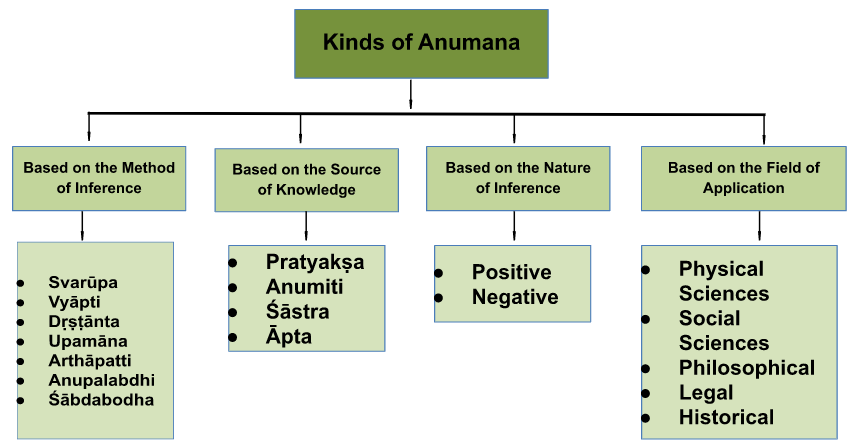Table of Contents
In Nyāya philosophy, the concept of anumāna, commonly known as inference, plays a crucial role in logical reasoning and the acquisition of knowledge. Anumāna involves the process of drawing conclusions based on evidence and observations, serving as a fundamental tool in the pursuit of understanding and truth.
This discussion will delve into the intricate structure of anumāna, explore its various types, and shed light on its significant role within Nyāya philosophy. By unraveling the essence of anumāna, we gain a deeper understanding of its importance in the realm of logical reasoning and knowledge acquisition.
UGC NET Study Notes for Paper 1
Structure of Anumāna
Anumāna comprises five essential components that provide a systematic framework for logical inference:
| Structure of Anumāna | ||
|---|---|---|
| 1. | Pratijñā (Proposition): | The journey of anumāna begins with the proposition, which represents the claim or thesis to be validated. It sets the foundation for the subsequent reasoning process. For instance, consider the proposition, “All mammals give birth to live young.” |
| 2. | Hetu (Reason): | The Hetu is the logical connection or reason that supports the proposition. It acts as the middle term, bridging the gap between the proposition and the evidence. For example, a suitable Hetu could be “Mammals possess mammary glands,” as these glands are typically associated with the ability to nourish and nurse live offspring. |
| 3. | Udāharaṇa (Example): | Udāharaṇa involves presenting specific instances or examples that serve as evidence supporting the proposition. These examples establish a foundation for generalization. For instance, examples such as humans, elephants, and dolphins can be cited to demonstrate that they are mammals and give birth to live young. |
| 4. | Upanaya (Application): | Upanaya involves applying the hetu to the examples provided in the udāharaṇa. It establishes a relationship between the reason and the specific instances. For example, upanaya would be recognizing that humans, elephants, and dolphins possess mammary glands and give birth to live young because they are mammals. |
| 5. | Nigamana (Conclusion): | The culmination of anumāna lies in the nigamana, the conclusion derived from the established relationship in the upanaya. It represents the logical consequence or generalization based on evidence and reasoning. For example, the nigamana would be “Therefore, all mammals give birth to live young.” |
Kind of Anumana

Based on the Method of Inference
| Method of Inference | Explain |
| Svarūpa (Property) Anumāna |
|
| Vyāpti (Universal) Anumāna |
|
| Dṛṣṭānta (Analogy) Anumāna |
|
| Upamāna (Comparison) Anumāna |
|
| Arthāpatti (Presumption) Anumāna |
|
| Anupalabdhi (Non-apprehension) Anumāna |
|
| Śābdabodha (Verbal Testimony) Anumāna |
|
Based on the Source of Knowledge
a) Pratyakṣa (Perception) Anumāna:
- Infers based on direct sensory perception of the external world.
- Example: Inferring the presence of a tree through visual and tactile perception.
b) Anumiti (Inference) Anumāna:
- Infers based on logical reasoning and deduction, making connections between observed facts or premises.
- Example: Inferring that a whale gives birth to live young based on the premise that all mammals do.
c) Śāstra (Scriptural) Anumāna:
- Infers based on scriptural texts or sacred scriptures.
- Example: Drawing conclusions about reality based on the authority and teachings of religious or philosophical texts.
d) Āpta (Expert) Anumāna:
- Infers based on the testimony or expertise of reliable authorities or experts in a specific field.
- Example: Accepting the validity of a scientific theory based on the statement of a renowned scientist.
Based on the Nature of Inference
a) Positive Anumāna:
- Infers the presence or existence of something. Draws conclusions that affirm the existence or occurrence of a particular entity or condition.
- Example: Inferring water’s presence based on wetness or dampness.
b) Negative Anumāna:
- Infers the absence or non-existence of something. Draws conclusions that negate the existence or occurrence of a particular entity or condition.
- Example: Inferring the absence of fire based on the absence of smoke or heat.
Based on the Field of Application:
a) Physical Sciences Anumāna:
- Infers phenomena in physics, chemistry, biology, and other natural sciences. Draws conclusions based on scientific principles, observations, and experiments.
- Example: Inferring subatomic particle behaviour from quantum mechanics.
b) Social Sciences Anumāna:
- Infers patterns in sociology, psychology, economics, and other social sciences. Analyzes social phenomena, data, and empirical studies to understand human behaviour and societal dynamics.
- Example: Inferring the impact of education on socioeconomic status through statistical analysis.
c) Philosophical Anumāna:
- Infers abstract concepts and philosophical truths. Uses logical reasoning to explore the nature of reality, existence, knowledge, and morality.
- Example: Inferring a transcendent reality through philosophical arguments.
d) Legal Anumāna:
- Infers legal conclusions and interpretations. Relies on legal principles, statutes, precedents, and evidence to draw conclusions in legal cases.
- Example: Inferring guilt or innocence based on presented evidence and legal arguments.
e) Historical Anumāna:
- Infers events and narratives from historical records and evidence. Analyzes documents, artefacts, testimonies, and archaeological findings to understand the past.
- Example: Inferring the sequence of events in a historical battle through accounts and archaeological discoveries.
In conclusion, these classifications provide a comprehensive understanding of the various types of anumāna, showcasing their diverse applications, methods, and sources. Each type of inference plays a crucial role in logical reasoning, expanding knowledge, and gaining insights into different fields of study. By employing these types of inferences, individuals can engage in critical thinking, make informed judgments, and navigate the complexities of the world around them.
Download Structure and kind of Anumana Study Notes PDF
The direct link to download Structure and kind of Anumana Study Notes PDF has been provided below. Candidate can click on below provided link to prepare for the UGC NET Examination.
Download Structure and kind of Anumana Study Notes PDF



 UGC NET Teaching Aptitude Questions Answ...
UGC NET Teaching Aptitude Questions Answ...
 Value Education and Environmental Educat...
Value Education and Environmental Educat...
 Research Ethics Meaning and Importance, ...
Research Ethics Meaning and Importance, ...









